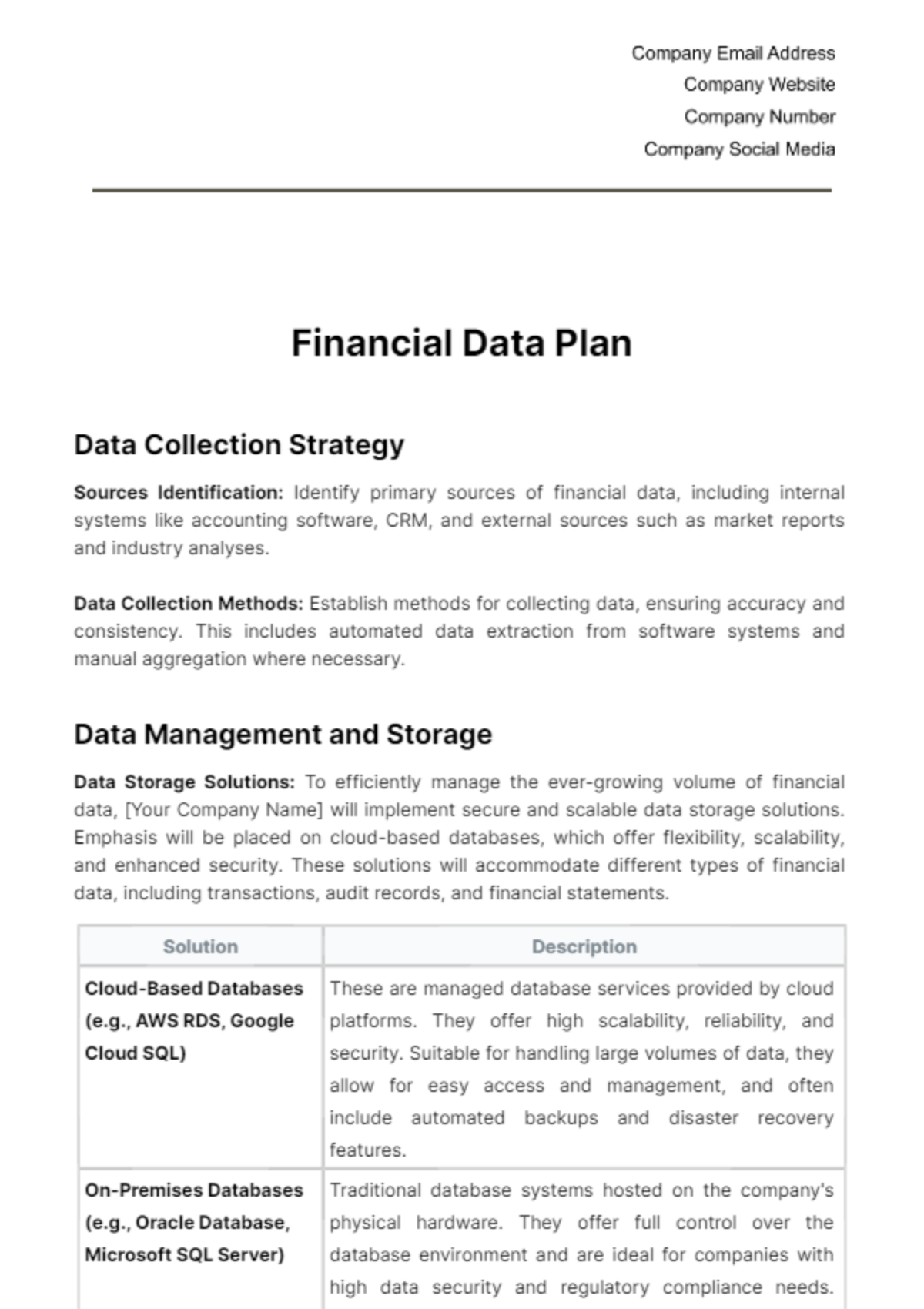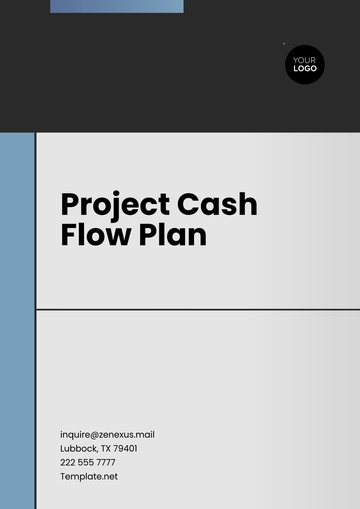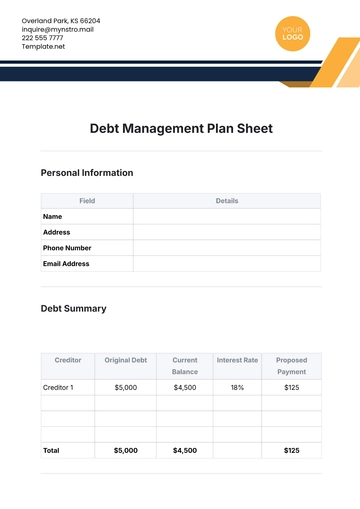Free Financial Data Plan

Data Collection Strategy
Sources Identification: Identify primary sources of financial data, including internal systems like accounting software, CRM, and external sources such as market reports and industry analyses.
Data Collection Methods: Establish methods for collecting data, ensuring accuracy and consistency. This includes automated data extraction from software systems and manual aggregation where necessary.
Data Management and Storage
Data Storage Solutions: To efficiently manage the ever-growing volume of financial data, [Your Company Name] will implement secure and scalable data storage solutions. Emphasis will be placed on cloud-based databases, which offer flexibility, scalability, and enhanced security. These solutions will accommodate different types of financial data, including transactions, audit records, and financial statements.
Solution | Description |
|---|---|
Cloud-Based Databases (e.g., AWS RDS, Google Cloud SQL) | These are managed database services provided by cloud platforms. They offer high scalability, reliability, and security. Suitable for handling large volumes of data, they allow for easy access and management, and often include automated backups and disaster recovery features. |
On-Premises Databases (e.g., Oracle Database, Microsoft SQL Server) | Traditional database systems hosted on the company's physical hardware. They offer full control over the database environment and are ideal for companies with high data security and regulatory compliance needs. However, they require significant upfront investment nd ongoing maintenance. |
Data Warehousing Solutions (e.g., Snowflake, Amazon Redshift) | Specialized for analytical processing, these solutions are designed to store and manage large amounts of data for reporting and analysis. They are optimized for fast query performance and are capable of handling complex data analytics tasks. |
Network Attached Storage (NAS) | A dedicated file storage server connected to a network. NAS systems are easy to set up and manage, offering a cost-effective solution for storing and sharing files within an organization. They are ideal for small to medium-sized businesses with moderate data storage needs. |
Hybrid Storage Solutions (e.g., Dell EMC, NetApp) | Combining cloud and on-premises storage, hybrid solutions offer the flexibility of cloud storage with the security and control of on-premises solutions. They are ideal for organizations looking to balance scalability with data sensitivity concerns. |
Data Organization: Effective data organization is key to quick and accurate data retrieval. Financial data will be meticulously categorized into distinct, meaningful categories like revenue, expenses, assets, liabilities, and equity. This categorization will be reflected in the database structure, allowing for streamlined data querying and analysis.
Data Quality Assurance
Accuracy Checks: Regular accuracy checks will be a cornerstone of our data management strategy. These checks will involve verifying that all financial data is up-to-date, correctly recorded, and reflects the true financial position of the company. Any discrepancies found will be promptly addressed.
Data Validation Processes: To maintain the integrity of financial data, stringent data validation rules and processes will be established. These will include checks for data entry errors, reconciliation of account balances, and validation of financial transactions against supporting documentation. Automated validation tools will be used where possible to enhance efficiency.
Process | Description | Expected Outcomes | Advantages |
|---|---|---|---|
Data Entry Error Checks | Regular checks for errors in data entry to ensure accuracy in financial records. | Increased accuracy in financial records and reports. Reduction in discrepancies and errors. | Enhances reliability of financial data, supports accurate decision-making. |
Account Balances Reconciliation | Periodic reconciliation of account balances to verify the accuracy of financial statements. | Assurance of financial statement integrity. Identification and correction of discrepancies. | Strengthens financial reporting accuracy, vital for audits and compliance. |
Transaction Validation | Validation of financial transactions against supporting documents like invoices and receipts. | Ensures each transaction is legitimate and properly recorded. | Reduces the risk of fraud and financial misstatement, improves audit readiness. |
Use of Automated Validation Tools | Incorporation of automated tools for efficient and error-free data validation. | Speeds up the data validation process, reduces manual errors. | Increases process efficiency, allows staff to focus on more strategic tasks. |
By implementing these data validation processes, [Your Company Name] aims to significantly enhance the accuracy and integrity of its financial data, leading to more reliable and informed financial decision-making. The use of automated tools, in particular, will contribute to greater operational efficiency and effectiveness in the finance department.
Data Analysis and Reporting
Analytical Tools Implementation: [Your Company Name] will leverage advanced analytical tools and software to delve into financial data, providing critical insights into the company's financial performance, emerging trends, and potential anomalies. These tools will enable deeper analysis of profitability, cost management, and investment returns.
Phase | Description | Estimated Timeline |
|---|---|---|
Selection and Procurement | Identify and acquire appropriate analytical tools and software based on company needs and data analysis objectives. | Q1 |
Infrastructure Setup and Integration | Set up necessary infrastructure and integrate new analytical tools with existing financial systems. | Q2 |
Staff Training | Conduct training sessions for employees to effectively use and understand the analytical tools. | Q2 - Q3 |
Pilot Testing | Initiate pilot testing of the tools to ensure proper functionality and integration with current processes. | Q3 - Q4 |
Full Implementation | Fully implement and leverage the analytical tools for comprehensive financial data analysis across the company. | By end of Q4 |
This timeline offers a systematic and phased approach, ensuring that each stage of implementation is thoroughly planned and executed for optimal integration of the analytical tools into [Your Company Name]'s financial analysis framework.
Reporting Mechanisms: We will develop robust reporting mechanisms tailored to different stakeholder needs. These will include monthly financial reports for operational monitoring, quarterly performance reviews for strategic decision-making, and comprehensive annual financial summaries for shareholders and regulatory bodies.
Compliance and Security
Regulatory Compliance: Adhering to financial reporting standards and privacy regulations is non-negotiable. Our data management practices will be continuously aligned with relevant regulations like GAAP, IFRS, and GDPR. Regular audits will be conducted to ensure ongoing compliance.
Data Security Measures: To safeguard sensitive financial information, [Your Company Name] will implement robust data security measures. These will include state-of-the-art encryption, stringent access controls, and regular security audits. Employee training on data security best practices will also be a priority to mitigate the risk of data breaches.
State-of-the-Art Encryption: Implement encryption technologies for securing financial data both in storage and during transmission.
Stringent Access Controls: Establish rigorous access control protocols to ensure only authorized personnel have access to sensitive financial data.
Regular Security Audits: Conduct periodic audits to identify and address any security vulnerabilities in the data management system.
Employee Training on Data Security: Provide comprehensive training for employees on best practices in data security and awareness of potential cybersecurity threats.
Incident Response Plan: Develop and maintain a robust incident response plan for effectively addressing and mitigating the impact of any data breaches.
Two-Factor Authentication (2FA): Implement 2FA for an additional layer of security, particularly for accessing critical financial systems.
Data Backup and Recovery Procedures: Establish regular data backup routines and have a clear recovery plan in case of data loss or corruption.
Monitoring and Alert Systems: Utilize advanced monitoring tools to detect unusual activities or access patterns that could indicate a security breach.
Each of these measures is aimed at fortifying the defenses of [Your Company Name] against data breaches and ensuring the integrity and confidentiality of financial information.
Continuous Improvement and Updates
Feedback Integration: Regularly gather feedback from data users to continuously improve data collection, management, and analysis processes.
Plan Updates: Periodically review and update the Financial Data Plan to incorporate new technologies, data sources, and best practices.
Prepared by:
[Your Name]
[Your Company Name]
[Your Email]
- 100% Customizable, free editor
- Access 1 Million+ Templates, photo’s & graphics
- Download or share as a template
- Click and replace photos, graphics, text, backgrounds
- Resize, crop, AI write & more
- Access advanced editor
Unlock financial success with Template.net's Financial Data Plan. A fully editable and customizable solution designed for your unique needs. Masterfully crafted and editable in our Ai Editor Tool, this comprehensive guide sparks financial clarity. Transform your financial data management today with precision, expertise and ease, only with Template.net.
You may also like
- Finance Plan
- Construction Plan
- Sales Plan
- Development Plan
- Career Plan
- Budget Plan
- HR Plan
- Education Plan
- Transition Plan
- Work Plan
- Training Plan
- Communication Plan
- Operation Plan
- Health And Safety Plan
- Strategy Plan
- Professional Development Plan
- Advertising Plan
- Risk Management Plan
- Restaurant Plan
- School Plan
- Nursing Home Patient Care Plan
- Nursing Care Plan
- Plan Event
- Startup Plan
- Social Media Plan
- Staffing Plan
- Annual Plan
- Content Plan
- Payment Plan
- Implementation Plan
- Hotel Plan
- Workout Plan
- Accounting Plan
- Campaign Plan
- Essay Plan
- 30 60 90 Day Plan
- Research Plan
- Recruitment Plan
- 90 Day Plan
- Quarterly Plan
- Emergency Plan
- 5 Year Plan
- Gym Plan
- Personal Plan
- IT and Software Plan
- Treatment Plan
- Real Estate Plan
- Law Firm Plan
- Healthcare Plan
- Improvement Plan
- Media Plan
- 5 Year Business Plan
- Learning Plan
- Marketing Campaign Plan
- Travel Agency Plan
- Cleaning Services Plan
- Interior Design Plan
- Performance Plan
- PR Plan
- Birth Plan
- Life Plan
- SEO Plan
- Disaster Recovery Plan
- Continuity Plan
- Launch Plan
- Legal Plan
- Behavior Plan
- Performance Improvement Plan
- Salon Plan
- Security Plan
- Security Management Plan
- Employee Development Plan
- Quality Plan
- Service Improvement Plan
- Growth Plan
- Incident Response Plan
- Basketball Plan
- Emergency Action Plan
- Product Launch Plan
- Spa Plan
- Employee Training Plan
- Data Analysis Plan
- Employee Action Plan
- Territory Plan
- Audit Plan
- Classroom Plan
- Activity Plan
- Parenting Plan
- Care Plan
- Project Execution Plan
- Exercise Plan
- Internship Plan
- Software Development Plan
- Continuous Improvement Plan
- Leave Plan
- 90 Day Sales Plan
- Advertising Agency Plan
- Employee Transition Plan
- Smart Action Plan
- Workplace Safety Plan
- Behavior Change Plan
- Contingency Plan
- Continuity of Operations Plan
- Health Plan
- Quality Control Plan
- Self Plan
- Sports Development Plan
- Change Management Plan
- Ecommerce Plan
- Personal Financial Plan
- Process Improvement Plan
- 30-60-90 Day Sales Plan
- Crisis Management Plan
- Engagement Plan
- Execution Plan
- Pandemic Plan
- Quality Assurance Plan
- Service Continuity Plan
- Agile Project Plan
- Fundraising Plan
- Job Transition Plan
- Asset Maintenance Plan
- Maintenance Plan
- Software Test Plan
- Staff Training and Development Plan
- 3 Year Plan
- Brand Activation Plan
- Release Plan
- Resource Plan
- Risk Mitigation Plan
- Teacher Plan
- 30 60 90 Day Plan for New Manager
- Food Safety Plan
- Food Truck Plan
- Hiring Plan
- Quality Management Plan
- Wellness Plan
- Behavior Intervention Plan
- Bonus Plan
- Investment Plan
- Maternity Leave Plan
- Pandemic Response Plan
- Succession Planning
- Coaching Plan
- Configuration Management Plan
- Remote Work Plan
- Self Care Plan
- Teaching Plan
- 100-Day Plan
- HACCP Plan
- Student Plan
- Sustainability Plan
- 30 60 90 Day Plan for Interview
- Access Plan
- Site Specific Safety Plan





























